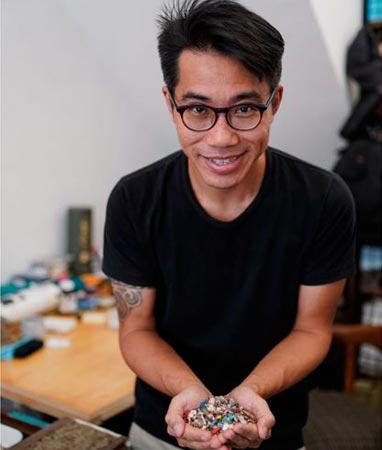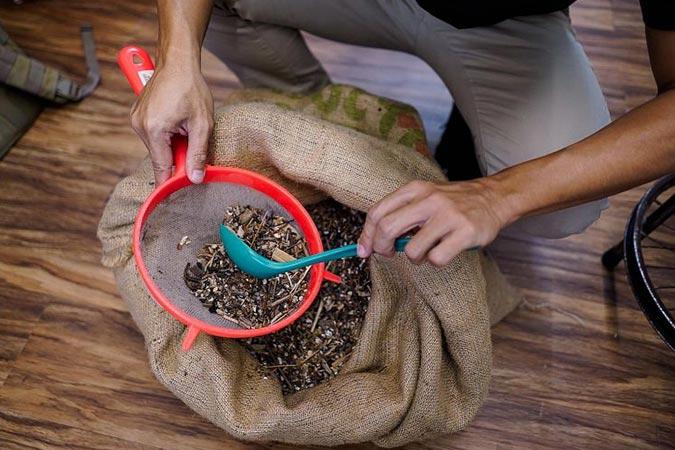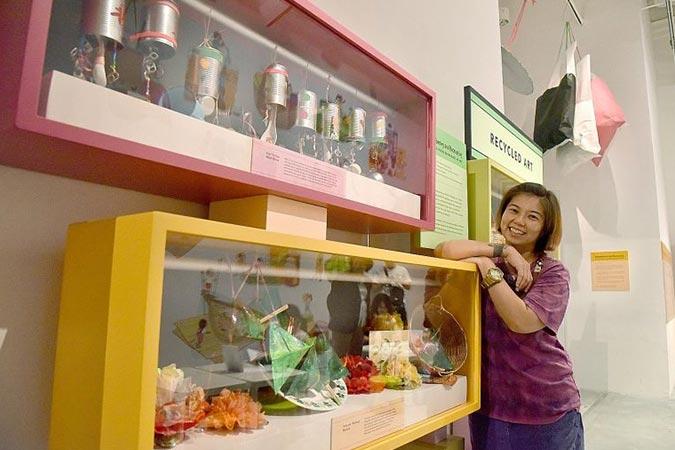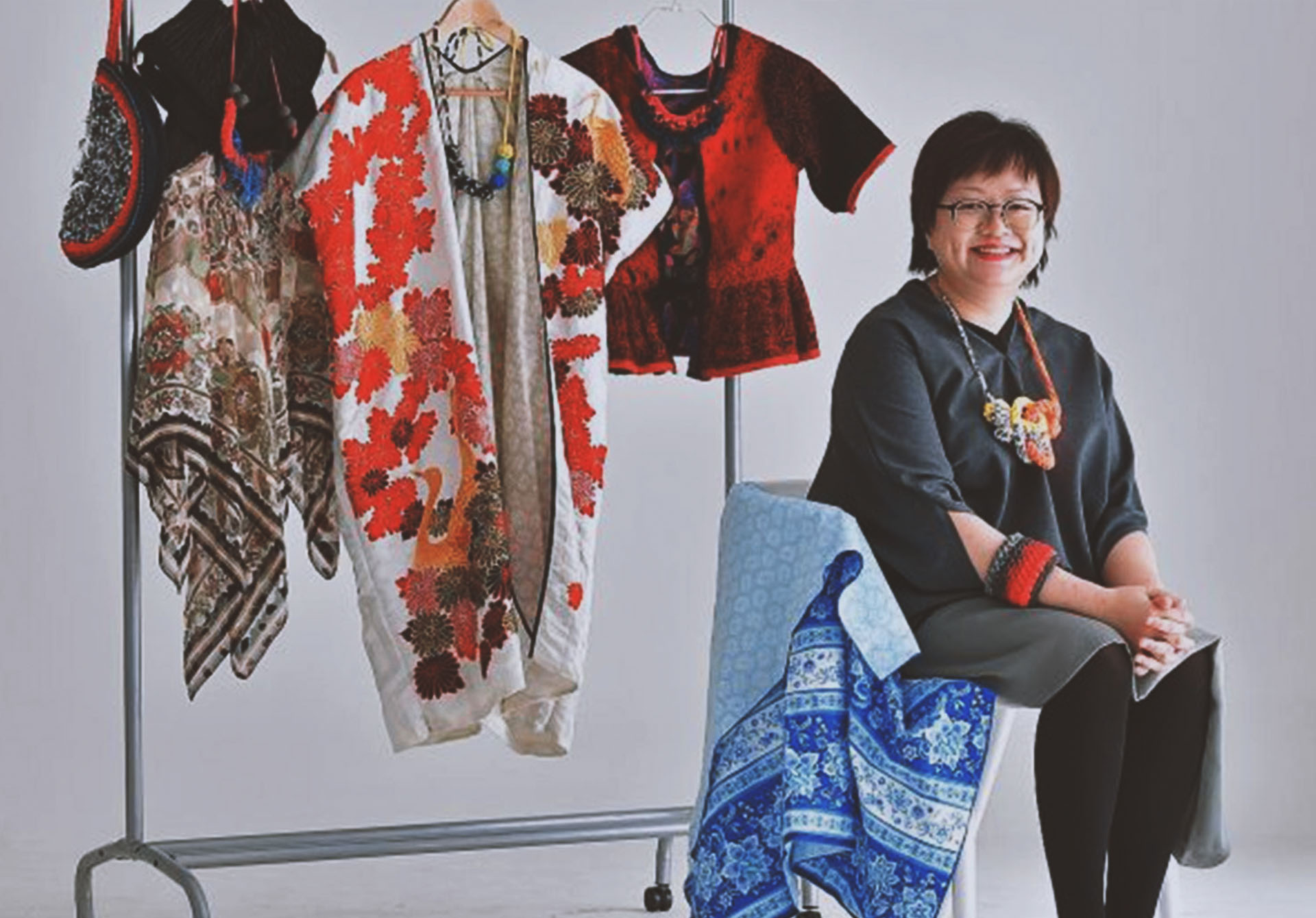One man's waste is another man's art. Fashion designer Adel Ng, artist Didier Ng and photographer Ernest Goh literally turn rubbish into art.
Didier Ng and Adel Ng both joke that their waste collections at home resemble karung guni (garbage man) heaps.
They tell The Sunday Times how they got into recycling and upcycling materials, and the challenges involved in remaking waste in creative ways.
ADEL NG, 38, FASHION DESIGNER
The founder of fashion label Mutawear turns recycled fabrics and yarns into knitted accessories and recycles vintage pieces into upcycled clothes.
She lives in a four-room Housing Board (HDB) flat with her husband, and her living room is her studio. All the fabrics she has collected for her work accumulates in the apartment, "only the master bedroom is clear", which leads to some lifestyle restrictions.
She has stopped asking friends over because, she says wryly, "I have a landfill in my living room".
She has also changed her cooking habits. "I cook only with water. I can't fry fish or chicken as the textiles will absorb the smell."
Reducing the amount of waste in fashion is one question that has preoccupied her throughout her career as fast fashion is wasteful and encourages over-consumption.
"It's very hard to work in fashion without dabbling in fast fashion."
HOW TO REDUCE FASHION WASTE
Fashion designer Adel Ng has five tips on reducing fashion waste.
-
Choose well, buy better, make it last. Quality over quantity, and really look into whether something was made ethically by workers being paid a fair wage.
-
Think about the material, the microplastics and the dry-cleaning. Was the fibre or fabric farmed or made sustainably? Laundry processes can seriously harm the environment too, so re-consider garments that can be cleaned only with chemicals.
-
Matchy-matchy? Does this lovely piece you covet match at least three or five other garments in your wardrobe?
-
B-Y-O tape measure. Know your own body measurements and, if in doubt, buy larger and get it altered to fit. This applies to online buys especially, as it is difficult to estimate if something fits or not.
-
Swop, thrift or rent. Turn clothes-swopping into a fun group activity with your friends, family and other communities.
-
Check out two videos Adel Ng did with Chinese newspaper Lianhe Zaobao for crafty ways to recycle: Turn an old T-shirt into a no-sew carrier bag and recycle an old bolster case into a bag.
Even the manufacturing process causes a lot of wastage. "During manufacturing, up to 20 per cent of textile is wasted. Therein lies the opportunity to turn waste into yarns that can be turned into things."
She makes her accessories from Hoooked yarns which are recycled from jersey T-shirts.
But even as she tries to make her label more sustainable, she is deeply aware of the irony of making more things that could possibly end up on the rubbish heap.
"I think about the post-product lifespan. If this garment is going to be discarded at the end of its life, how recyclable is it?"
Like artist Didier Ng, Adel Ng is a firm believer in repairing. "If there is repair, there's not so much throwaway," she says.
ERNEST GOH, 40, PHOTOGRAPHER

Photographer Ernest Goh's Shore Debris Table installation features debris he collected from Punggol beach and invites people to use tweezers to pick out bits of microplastics. ST PHOTO: ONG WEE KIAT
Goh's latest work explores the seemingly endless lifespan of plastics in an interactive art installation that travelled to Malaysia for the Georgetown arts festival last month.
He spent three days collecting two gunny sacks worth of debris from Punggol beach for his Shore Debris Table. It is currently on display at the Temasek Shophouse until Aug 16.
The table, cobbled together from driftwood and recycled wood, holds the debris and people are invited to sit around it and use tweezers to pluck out bits of microplastics.
The idea was borne of his personal encounters. He says: "When I went to the beach, I took tweezers and starting picking out microplastics. I was personally quite amazed by how much there was in Punggol."
The avid diver also wanted to make people think about the effects of microplastics on the food chain. "One thing that really got me is how the fish are eating these bits of plastic waste because they look like food. And we are eating the fish."

Photographer Ernest Goh's Shore Debris Table installation features debris (above) he collected from Punggol beach and invites people to use tweezers to pick out bits of microplastics. ST PHOTO: ONG WEE KIAT
Thus his work also incorporates the idea of food as people are invited to consume food and drinks over the table before the debris is unveiled for diners to experience the chore of picking out plastic pieces.
Goh says reactions have varied from some people asking if the microplastics are planted to people getting offended because the work confronts them with their trash.
He adds: "We need to redefine and re-examine our relationship with trash. When you dump it, it's easier to say 'It's not my problem. It's the trash collectors' problem, the Government's problem.'"
DIDIER NG, 37, ECO-ARTIST

Works by eco-artist Didier Ng , made from recycled materials, are on display at the National Museum of Singapore's Packaging Matters exhibition. ST PHOTO: JASMINE CHOONG
This artist walks the eco-talk when it comes to reducing waste.
Her wallet is recycled from a fruit drink carton, folded accordion-style to create compartments for notes and coins while the plastic screwtop holds a bit of yarn on which is threaded her keys.
Her works are made with 90 per cent recycled materials.
An oversized milk carton she made for the National Museum of Singapore's Packaging Matters exhibition, which is on until Sept 15, is recycled from an LG cardboard box.
Her studio is her family's HDB home, so all her works have to fit in the HDB lift.
She inherited her father's instinct to repair and reuse things.
"My dad will pick up stuff and fix it. Sometimes, he even sells stuff he fixes."
Her ideas for her installations are inspired by the bits and bobs she has accumulated.
"I picked up about 80 umbrellas left over from a workshop, so I'm making an umbrella forest for the PAssion arts festival. If I picked up pots, it would be a pot forest."
She will also try to recycle materials from an installation after the exhibition ends.
"It takes more effort to recycle, but there's a satisfaction. I like the challenge of expanding the lifespan of a material."
This article is produced in partnership with ST Life.
